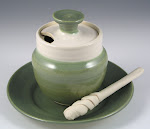 |
| Price Green- almost more blue than green. (Viewing the color depends on your browser settings, though.) |
Late last week I went into my ceramic supplier to pick up some wax resist and a couple of small tools. I also wanted some black nickel oxide, an ingredient in a recipe for Price Green, a great, fat green-blue glaze I came across lately when I wasn't even looking. In an offhand way, without paying much attention, I figured I will make a bunch of buckets of this glaze over the next couple of years, so I'd better stock up. "Five lbs of black nickel oxide, please."
The cashier got it from a shelf behind the desk. (I hadn't asked the price. I should have been tipped off by where they keep it.) Ringing it up, she noted, "I'm just letting you know this is very expensive."
"What's 'very expensive'?"
"$280."
Oops. Reality check. Black nickel oxide is the least ingredient in the recipe- like the food coloring in frosting, if you will. I am not sure where my brain was with that 5 lbs. I bought a quarter lb, less than $15 worth, which will probably do for the next eight buckets of Price Green, after which I may have moved on to a whole 'nother color palette. (Talk about studio practicalities!)
Meanwhile, I still have enough of this color and others, already mixed up in buckets, to glaze a few loads for the kiln.
Here is a typical glaze phase in the studio. There are bisqued but still-to-be-glazed pots (washing cups and small dishes on the left), glazed but unfired pots (the chalky looking brown and white ones on the right), and fired pots (those black bowls) that need to be refired with glaze touchups.
My old kiln will run one of its last two glaze firings this week. When the new kiln arrives in a few weeks, the old kiln will run for bisque firings only and no longer have the higher wear and tear of glaze firings. My good old workhorse, 25 years old, will be on light duty from now on.


exciting! I LOVE the piece up above! Love the colors!!!!
ReplyDeleteHey Shana, thank you! I believe that with more control over the temperatures during the course of firing, I am going to be getting richer colors. Really need some!
DeleteHow much do the expensive ingredients cost?
ReplyDeleteDoes this mean you can program it once, rather than having to remember to change the switches?
Gila, ingredients vary much in price, but a 25 lb bucket of dry, powdered flint (silica, a very basic glaze ingredient) is about $20. Colorants are much more. Cobalt carbonate, for blue, (for example) is about $42 for only one lb.
DeleteThe programmable controller is set once before each firing, and takes itself through to the finish. It'll be a learning process for me, as to what will be the most successful temperature program to put together, complete with rate of climb and rate of fall! -and different glazes will respond differently. But I won't be reinventing the wheel. People have done this before & I will learn.